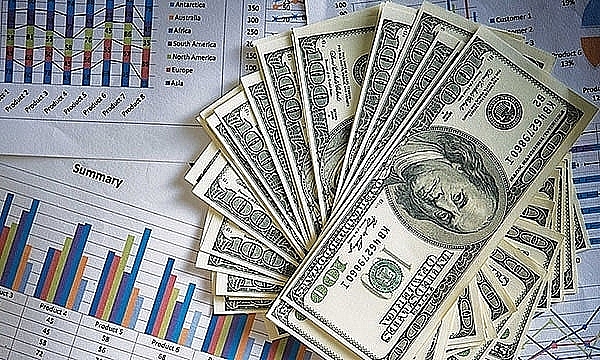 |
| Interest rate differentials can affect global trade dynamics. |
Influence global trade dynamics
| According to statistics from the General Department of Customs, in the first five months of 2024, exports to 27 European countries reached US$20.29 billion, an increase of 14.1 percent, equivalent to an increase of US$2.52 billion compared to the same period last year. In the opposite direction, Vietnam’s imports from Europe reached US$6.29 billion, up 9.6 percent compared to the same period last year. Of which, textile exports to Europe reached US$1.78 billion, down 1.6 percent; Electronic products and components group with US$3.44 billion, a sharp increase of 50.9 percent; footwear group of all kinds reached US$2.59 billion, up 11.3 percent compared to the same period last year. |
In early June, the ECB reduced the deposit interest rate from 4 percent to 3.75 percent since the first cut in 2019. The decision is said to have been influenced by the decline in inflation, which fell from more than 10 percent at the end of 2022 to close to the ECB’s 2 percent target. Similarly, the BoC cut its benchmark interest rate by 25 basis points to 4.75 percent, marking the end of a series of interest rate hikes to fight inflation. The People’s Bank of China (PBC) has been more proactive in easing measures, cutting key interest rates to support economic recovery amid slowing growth and deflation risks.
However, in a recent meeting, the US Federal Reserve (Fed) decided to keep the policy interest rate unchanged in the range of 5.25-5.5 percent to maintain pressure on the economy to cool inflation, but lowered the prospect of cutting interest rates to just once this year. In addition, the Bank of England (BoE) also maintains high interest rates, currently at 5.25 percent, due to ongoing inflation concerns. The Bank of Japan (BoJ) announced to raise short-term interest rates to about 0-0.1 percent from negative 0.1 percent.
According to experts, differences in monetary policy between major central banks can lead to different economic outcomes. Interest rate differentials can impact currency values, affecting global trade dynamics. For example, a weaker Euro or Canadian Dollar (CAD) could make exports from these regions more competitive, potentially improving the trade balance, but could also increase import costs, contributing to inflationary pressures.
Chu Thanh Tuan, Vice Head of the Bachelor of Business Group at RMIT University commented that Vietnam is an export-oriented economy, very susceptible to global economic fluctuations. Recent interest rate cuts by major central banks such as the ECB and BoC could lead to currency fluctuations and change global trade dynamics, affecting Vietnam’s export market.
Specifically, interest rate cuts by the ECB and BoC could cause the Euro and Canadian Dollar to lose value. This makes European and Canadian goods cheaper on the global market, potentially affecting Vietnam’s exports as goods become relatively more expensive. However, falling lending costs in Europe and Canada could boost economic activity in these regions, supporting increased consumer demand, which in turn could benefit industries such as textiles, electronics and agriculture – which are sectors that contribute significantly to Vietnam’s exports. In addition, a weaker Euro and Canadian Dollar could make imports cheaper from these regions, helping to reduce input costs for Vietnamese businesses.
Diversify markets and improve export competitiveness
For the Canadian market, this is considered a potential market and a “gateway” to access the North American market. Therefore, the export turnover of Vietnamese goods to Canada in the first 3 months of 2024 will reach more than US$1.5 billion, an increase of 28 percent compared to the previous year. The item with the largest export turnover to the Canadian market is still textiles and garments, with a value of US$256.06 million, an increase of 10.5 percent, accounting for 17 percent of the export proportion.
With such high import and export turnover and value, experts say that Vietnamese businesses need to proactively prepare to catch and respond to fluctuations in other countries’ monetary policies. Dr. Chu Thanh Tuan recommends strengthening trade policy through diversifying export markets, which can help minimize risks related to currency fluctuations and economic downturns in certain regions. Along with that, we must improve export competitiveness by focusing on promoting the quality and added value of Vietnamese exports to maintain competitiveness despite currency changes.
Currently, many Vietnamese businesses have been making efforts to improve product quality and find opportunities to expand the market. For example, to increase export capabilities, startup brand Nam Tural has researched and produced the product Eco Firelighters – pellets made from straw used to start fires for cooking activities when camping, lighting fireplaces… With environmentally friendly characteristics, meeting consumer needs, bringing the product to the Amazon e-commerce platform, this product has been exported and distributed in Canada and the US.
Or with textile and garment enterprises, the market diversification strategy has been promoted.
According to the Vietnam Textile and Apparel Association, Vietnamese textile and garment enterprises have exported to 104 global markets. With export turnover to Europe decreasing over the past 5 months, businesses are promoting exports to the ASEAN and Asian markets in general, as well as bringing products to African and Middle East markets.
In addition, with the interest rate cuts of the ECB and BoC, the expert from RMIT University said that the Government needs to implement a flexible exchange rate policy and build strong foreign exchange reserves to cope with external shocks and maintain economic stability. Furthermore, the Government needs to strengthen economic resilience by promoting domestic consumption to reduce the economy’s vulnerability to external shocks.
